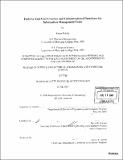| dc.contributor.advisor | David R. Karger. | en_US |
| dc.contributor.author | Bakshi, Karun, 1974- | en_US |
| dc.contributor.other | Massachusetts Institute of Technology. Dept. of Electrical Engineering and Computer Science. | en_US |
| dc.date.accessioned | 2005-09-26T20:43:16Z | |
| dc.date.available | 2005-09-26T20:43:16Z | |
| dc.date.copyright | 2004 | en_US |
| dc.date.issued | 2004 | en_US |
| dc.identifier.uri | http://hdl.handle.net/1721.1/28487 | |
| dc.description | Thesis (S.M.)--Massachusetts Institute of Technology, Dept. of Electrical Engineering and Computer Science, 2004. | en_US |
| dc.description | Includes bibliographical references (p. 107-108). | en_US |
| dc.description.abstract | Information based tasks rely on software applications that allow users to interact with information in some pre-defined manner deemed appropriate by the application developer or information/content provider. Whereas such an approach facilitates one way of working with the information, it does not (and cannot) take into account the unique needs of the user, e.g., the particular content of interest given the specific task being performed and expertise of the user, information visualization and interaction preferences of the user, etc. As a result, users must perform additional overhead information management activities in working with the software tools in order to accomplish their particular tasks. In this thesis, we advocate breaking the "rigidity" of such applications by allowing users to create and customize their own task-oriented interfaces (information spaces) that aggregate and present task-specific information and tools on the same screen. In developing a system that allows users to tailor an information space in a manner that suits their particular task and preferences, we recognize a set of desirable properties it must have, and the need for it to provide the user customization control over three primary aspects of information in their information space: content, presentation and manipulation. Haystack, a generalized information management system, encompasses many of the desirable properties at the system level and also provides many of the building blocks that are required to give users greater customization control. We thus approach our ultimate goal of enabling users to build and configure a personalized task-oriented interface by providing them with tools situated in Haystack that allow manipulating various primitives that control | en_US |
| dc.description.abstract | (cont.) the three aspects of information spaces. A discussion of the design and implementation of each of the tools is provided. The above solution allows users to develop information spaces that better match their unique conception of the task and eliminate much of the overhead resulting from "rigid" information management tools, resulting in productivity gains in recurring or long-running tasks. | en_US |
| dc.description.statementofresponsibility | by Karun Bakshi. | en_US |
| dc.format.extent | 108, [8] p. | en_US |
| dc.format.extent | 9613055 bytes | |
| dc.format.extent | 9627004 bytes | |
| dc.format.mimetype | application/pdf | |
| dc.format.mimetype | application/pdf | |
| dc.language.iso | en_US | |
| dc.publisher | Massachusetts Institute of Technology | en_US |
| dc.rights | M.I.T. theses are protected by copyright. They may be viewed from this source for any purpose, but reproduction or distribution in any format is prohibited without written permission. See provided URL for inquiries about permission. | en_US |
| dc.rights.uri | http://dspace.mit.edu/handle/1721.1/7582 | |
| dc.subject | Electrical Engineering and Computer Science. | en_US |
| dc.title | Tools for end-user creation and customization of interfaces for information management tasks | en_US |
| dc.title.alternative | Assessing cohesion via pattern mining : representation and models | en_US |
| dc.type | Thesis | en_US |
| dc.description.degree | S.M. | en_US |
| dc.contributor.department | Massachusetts Institute of Technology. Department of Electrical Engineering and Computer Science | |
| dc.identifier.oclc | 57253719 | en_US |
